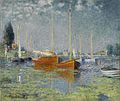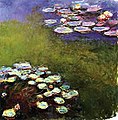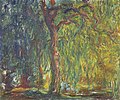Claude Monet: Difference between revisions
→Death: Musée de l'Orangerie |
→Death: m |
||
| Line 105: | Line 105: | ||
==Death== |
==Death== |
||
[[Image:Claude Monet 038.jpg|thumb|400px|''[[Water |
[[Image:Claude Monet 038.jpg|thumb|400px|''[[Water Lilies]]'', 1920-1926, [[Musée de l'Orangerie]]]] |
||
Monet died of lung cancer on [[December 5]], [[1926]] at the age of 86 and is buried in the [[Giverny]] church cemetery.<ref>[http://giverny.org/giverny/ The village of Giverny] giverny.org. Retrieved [[6 January]] 2007.</ref> Monet had insisted that the occasion be simple; thus, only about fifty people attended the ceremony.<ref>P. Tucker ''Claude Monet: Life and Art'', p.224</ref> |
Monet died of lung cancer on [[December 5]], [[1926]] at the age of 86 and is buried in the [[Giverny]] church cemetery.<ref>[http://giverny.org/giverny/ The village of Giverny] giverny.org. Retrieved [[6 January]] 2007.</ref> Monet had insisted that the occasion be simple; thus, only about fifty people attended the ceremony.<ref>P. Tucker ''Claude Monet: Life and Art'', p.224</ref> |
||
Revision as of 23:37, 1 October 2007
Claude Oscar Monet | |
|---|---|
| File:ClaudeMonet.jpg | |
| Born | Claude Oscar Monet |
| Nationality | French |
| Known for | Painter |
| Movement | Impressionism |
Claude Monet (French IPA: [klod mɔ'nɛ) also known as Oscar-Claude Monet or Claude Oscar Monet (November 14, 1840 – December 5, 1926)[1] was a founder of French impressionist painting, and the most consistent and prolific practitioner of the movement's philosophy of expressing one's perceptions before nature, especially as applied to plein-air landscape painting.[2] The term Impressionism is derived from the title of his painting Impression, Sunrise.
Early life

Monet was born on November 14, 1840 on the fifth floor of 45 rue Laffitte, in the ninth arrondissement of Paris.[3] He was the second son of Claude-Adolphe and Louise-Justine Aubrée Monet, both of them second-generation Parisians. On May 20, 1841, he was baptized in the local parish church, Notre-Dame-de-Lorette as Oscar-Claude. [3] In 1845, his family moved to Le Havre in Normandy. His father wanted him to go into the family grocery store business, but Claude Monet wanted to become an artist. His mother was a singer.
On the first of April 1851, Monet entered the Le Havre secondary school of the arts. He first became known locally for his charcoal caricatures, which he would sell for ten to twenty francs. Monet also undertook his first drawing lessons from Jacques-François Ochard, a former student of Jacques-Louis David. On the beaches of Normandy in about 1856/1857 he met fellow artist Eugène Boudin who became his mentor and taught him to use oil paints. Boudin taught Monet "en plein air" (outdoor) techniques for painting.[4]
On 28 January, 1857 his mother died. He was 16 years old when he left school, and went to live with his widowed childless aunt, Marie-Jeanne Lecadre.
Paris

When Monet traveled to Paris to visit The Louvre, he witnessed painters copying from the old masters. Monet, having brought his paints and other tools with him, would instead go and sit by a window and paint what he saw. Monet was in Paris for several years and met several painters who would become friends and fellow impressionists. One of those friends was Édouard Manet.
In June of 1861 Monet joined the First Regiment of African Light Cavalry in Algeria for two years of a seven-year commitment, but upon his contracting typhoid his aunt Madame Lecadre intervened to get him out of the army if he agreed to complete an art course at a university. It is possible that the Dutch painter Johan Barthold Jongkind, whom Monet knew, may have prompted his aunt on this matter. Disillusioned with the traditional art taught at universities, in 1862 Monet became a student of Charles Gleyre in Paris, where he met Pierre-Auguste Renoir, Frédéric Bazille, and Alfred Sisley. Together they shared new approaches to art, painting the effects of light en plein air with broken color and rapid brushstrokes, in what later came to be known as Impressionism.
Monet's 1866 Camille or The Woman in the Green Dress (La Femme à la Robe Verte), which brought him recognition, was one of many works featuring his future wife, Camille Doncieux. Shortly thereafter Doncieux became pregnant and bore their first child, Jean. In 1868, due to financial reasons, Monet attempted suicide by throwing himself into the Seine.
Franco-Prussian War

After the outbreak of the Franco-Prussian War (July 19, 1870), Monet took refuge in England in September 1870.[5] While there, he studied the works of John Constable and Joseph Mallord William Turner, both of whose landscapes would serve to inspire Monet's innovations in the study of color. In the Spring of 1871, Monet's works were refused to be included in the Royal Academy exhibition. [6]
In May 1871 he left London to live in Zaandam[6], where he made 25 paintings (and the police suspected him of revolutionary activities [7]). He also had a first visit to nearby Amsterdam. In October or November 1871 he returned to France. Monet lived from December 1871 to 1878 at Argenteuil, a village on the Seine near Paris, and here he painted some of his best known works. In 1874, he briefly returned to Holland.[8]
In 1872 (or 1873), he painted Impression, Sunrise (Impression: soleil levant) depicting a Le Havre landscape. It hung in the first Impressionist exhibition in 1874 and is now displayed in the Musée Marmottan-Monet, Paris. From the painting's title, art critic Louis Leroy coined the term "Impressionism", which he intended to be derogatory, however the Impressionists appropriated the term for themselves.[9]
Monet and Camille Doncieux had married just before the war (June 28 1870) [6] and, after their excursion to London and Zaandam, they had moved into a house in Argenteuil near the Seine River in December 1871. She became ill in 1876. They had a second son, Michel, on March 17, 1878, (Jean was born in 1867). This second child weakened her already fading health. In that same year, he moved to the village of Vétheuil. At the age of thirty-two, Madame Monet died on 5 September, 1879 of tuberculosis; Monet painted her on her death bed.[10] [11]
Gallery of early paintings
-
The Woman in the Green Dress, Camille Doncieux, 1866
-
Le dejeuner sur lherbe, (right section), with Gustave Courbet, 1865-1866, Musée d'Orsay, Paris, France
-
Jardin à Sainte-Adresse, 1867, Metropolitan Museum of Art
-
La Grenouillére, 1869, Metropolitan Museum of Art
-
The Artist's House at Argenteuil, 1873, The Art Institute of Chicago
-
Street near Vétheuil in Winter, 1879
Later life
After several difficult months following the death of Camille, a grief stricken Monet (resolved never to be mired in poverty again) began in earnest to create some of his best paintings of the 19th century. During the early 1880's Monet painted several groups of landscapes and seascapes in what he considered to be campaigns to document the French countryside. His extensive campaigns evolved into his series' paintings. Monet moved into the home of Ernest Hoschedé, a wealthy department store owner and patron of the arts. After her husband was bankrupted, Alice Hoschedé, continued to live in their home in Poissy with Monet and helped to raise his two sons, Jean and Michel, alongside her own six children. They were Blanche, Germaine, Suzanne, Marthe, Jean-Pierre, and Jacques. In April 1883 they moved to Vernon, then to a house in Giverny, Eure, in Upper Normandy, where he planted a large garden where he painted for much of the rest of his life. Following the death of her estranged husband, Alice Hoschedé married Claude Monet in 1892.[4]
In the 1880s and 1890s, Monet worked on "series" paintings, in which a subject was depicted in varying light and weather conditions. His first series exhibited as such was of Haystacks, painted from different points of view and at different times of the day. Fifteen of the paintings were exhibited at the Durand-Ruel in 1891. He later produced series of paintings of Rouen Cathedral, poplars, the Houses of Parliament, mornings on the Seine, and the water-lilies on his property at Giverny.
Monet was exceptionally fond of painting controlled nature: his own garden in Giverny, with its water lilies, pond, and bridge. He also painted up and down the banks of the Seine.
Between 1883 and 1908, Monet traveled to the Mediterranean, where he painted landmarks, landscapes, and seascapes, such as Bordighera. He painted an important series of paintings in Venice, Italy, and in London he painted two important series — views of Parliament and views of Charing Cross Bridge. His wife Alice died in 1911 and his oldest son Jean, who had married Alice's daughter Blanche, Monet's particular favourite, died in 1914.[4] After his wife died, Blanche looked after and cared for him. It was during this time that Monet began to develop the first signs of cataracts.[12]
During World War I, in which his younger son Claude served and his friend and admirer Clemenceau led the French nation, Monet painted a series of Weeping Willow trees as homage to the French fallen soldiers. Cataracts formed on Monet's eyes, for which he underwent two surgeries in 1923. The paintings done while the cataracts affected his vision have a general reddish tone, which is characteristic of the vision of cataract victims. It may also be that after surgery he was able to see certain ultraviolet wavelengths of light that are normally excluded by the lens of the eye, this may have had an effect on the colors he perceived. After his operations he even repainted some of these paintings, with bluer water lilies than before the operation. [13]
Gallery of later paintings
-
Still-Life with Anemones, 1885
-
The Port Coton „Pyramids, 1886
-
Poplars, (autumn), 1891, Philadelphia Museum of Art
-
Branch of the Seine near Giverny, 1897
-
Bridge over a Pool of Water Lilies, 1899, Metropolitan Museum of Art
-
Garden Path, 1902
-
Sea-Roses (Yellow Nirwana), 1920, The National Gallery, London
Death

Monet died of lung cancer on December 5, 1926 at the age of 86 and is buried in the Giverny church cemetery.[14] Monet had insisted that the occasion be simple; thus, only about fifty people attended the ceremony.[15]
His famous home and garden with its waterlily pond were bequeathed by his heirs to the French Academy of Fine Arts (part of the Institut de France) in 1966. Through the Fondation Claude Monet, the home and gardens were opened for visit in 1980, following refurbishment.[16] In addition to souvenirs of Monet and other objects of his life, the home contains his collection of Japanese woodcut prints. The home is one of the two main attractions of Giverny, which hosts tourists from all over the world.
Posthumous sales
In 2004, London, the Parliament, Effects of Sun in the Fog (Londres, le Parlement, trouée de soleil dans le brouillard) (1904), sold for U.S. $20.1 million.[17] In 2006, the journal Proceedings of the Royal Society published a paper providing evidence that these were painted in situ at St Thomas' Hospital over the river Thames.
Falaises près de Dieppe (Cliffs near Dieppe) has been stolen on two separate occasions. Once in 1998 (in which the museum's curator was convicted of the theft and jailed for five years along with two accomplices) and most recently in August 2007. It has yet to be recovered[18].
See also
- Haystacks (Monet)
- London Parliament (Monet)
- Rouen Cathedral (Monet)
- Water Lilies
- History of painting
- Western painting
References
- Cited
- ^ Biography of Claude Monet giverny.org. Retrieved 6 January 2007.
- ^ House, John, et al: Monet in the 20th Century, page 2. Yale University Press, 1998.
- ^ a b P. Tucker Claude Monet: Life and Art, p.5
- ^ a b c Biography for Claude Monet Guggenheim Collection. Retrieved 6 January 2007.
- ^ Monet, Claude Nicolas Pioch, www.ibiblio.org, 19 September 2002. Retrieved 6 January 2007.
- ^ a b c Charles Stuckey "Monet, a Retrospective", Hugh Lauter Levin Associates, 195
- ^ The texts of seven police reports, written on 2 June – 9 October 1871 are included in Monet in Holland, the catalog of an exhibition in the Amsterdam Van Gogh Museum (1986).
- ^ His paintings are shown and discussed here.
- ^ Impressionism — Overview ARTinthePICTURE.com. Retrieved 6 January 2007.
- ^ http://www.artelino.com/articles/la_japonaise.asp accessed September 25 2007
- ^ http://members.aol.com/wwjohnston/camille.htm accessed September 25 2007
- ^ Forge, Andrew, and Gordon, Robert, Monet, page 224. Harry N. Abrams, 1989.
- ^ Let the light shine in Guardian News, 30 May 2002. Retrieved 6 January 2007.
- ^ The village of Giverny giverny.org. Retrieved 6 January 2007.
- ^ P. Tucker Claude Monet: Life and Art, p.224
- ^ http://www.fondation-monet.com/uk/propriete/index.html
- ^ Monet's masterpiece reaches record high bid newsfromrussia.com, 5 November 2004. Retrieved 6 January 2007.
- ^ "Monet and Others Stolen in Museum Heist in Nice" (Web). artforum.com. 8 August 2007. Retrieved 8 August 2007.
{{cite web}}: Cite has empty unknown parameter:|coauthors=(help)
- General
- A Monet biography
- Biography at Musee Claude Monet à Giverny
- Biography of Claude MONET
- Monet in Amsterdam
- Tucker, Paul Hayes. Claude Monet: Life and Art. Italy: Amilcare Pizzi. ISBN 0300062982. OCLC 31409541.
{{cite book}}:|access-date=requires|url=(help) - ed. Richard Kendall, Monet by Himself, (Macdonald & Co 1989, updated Time Warner Books 2004), ISBN 0316728012
External links
- Hecht Museum
- Claude Monet Images
- Monet page at Webmuseum
- Monet images at Fine Arts Museums of San Francisco
- Claude Monet by himself
- Life of Monet a timeline of Monet's life
- Claude Monet at the Museum of Modern Art (MoMA)
- Will the real Monet please stand up?
- Monet gallery
- Monet
- Monet at Cincinnati Museum of Art
- Claude Monet at Hill-Stead Museum, Farmington, Connecticut
- The Unknown Monet Exhibition held at the Sterling and Francine Clark Art Institute June 23-September 16, 2007


































